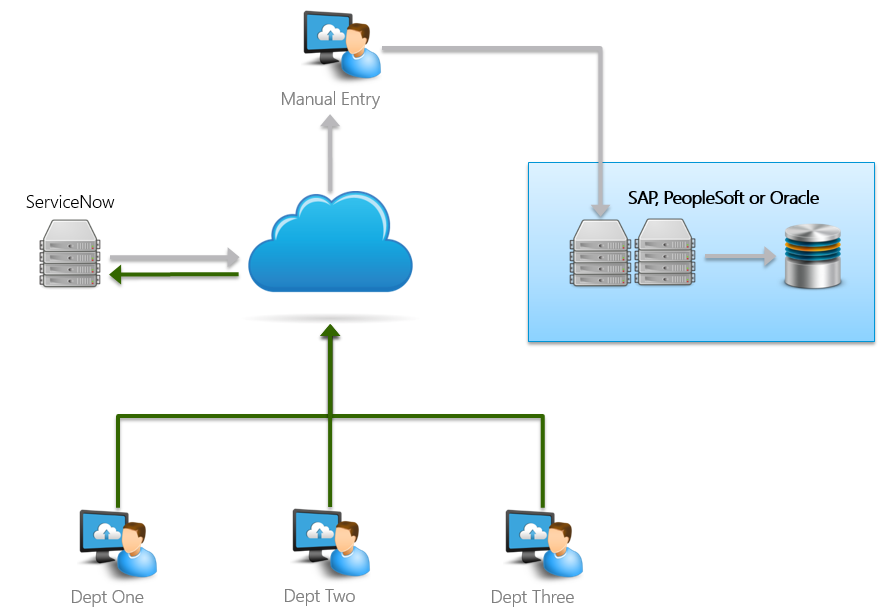Straight-Through Processing with ServiceNow

How much time is your organisation wasting on manual processes?
What is the true cost of lost productivity?
Straight-through processing (STP) has long been recognised as the Holy Grail of business processes, as it promises to eliminate manual paper forms along with human intervention at the back end. By avoiding the duplication of effort, straight-through processing promises to drastically improve the speed and accuracy of business processes.
Although straight-through processing has been attempted by numerous enterprise applications, such as SAP, IBM and Oracle, the problem has been that no single system handles data collection in a consistent, comprehensive manner.
Single System of Record
ServiceNow is unique among enterprise applications in that it uses a single system of record with common/shared supporting processes, such as workflows and notifications. Although there are hundreds of tables in the ServiceNow database, they are all closely related, and are often based on the two core tables — CI (Configuration Item in a CMDB) and Task. In ordinary business terms, CI and Task translate into objects and actions—and ultimately, all business processes revolve around things/people, and actions applied to them.

Source: https://thisiswhatgoodlookslike.files.wordpress.com/2014/05/platform.png
By using a common architecture for all applications, ServiceNow avoids the problem of integrating with conflicting data structures/applications. In essence, everything speaks the same language.
Straight-through processing
ServiceNow has a single system of record, making it ideally suited to straight-through processing. ServiceNow has the flexibility to adapt to multiple different application requirements whilst leveraging common structures and components. For example, fleet car management, purchase orders, and timesheet entries are entirely different business processes, but in essence they deal with objects (cars/orders/people) and activities (driving/tracking expenditure/working hours), and have similar requirements (approvals, workflow, records management, notifications, common master data, etc).
Essentially, the ServiceNow Automation Platform allows different business processes to be captured without changing the underlying system.
JDS recommends deploying straight-through processing in an iterative manner, using an agile approach.
- Validate user input with the target system
- Digitise paper forms
- Straight-through processing
- Automation
By adopting an agile approach with implementation in phases, organisations can see incremental benefits throughout the project.
Phase One: Validate user input with the target system
For straight-through processing to be successful, ServiceNow needs to validate incoming information to ensure it’s compatible with the target system. To do this, ServiceNow forms need to be pre-populated with values taken from the core system.

For example, organisational data such as cost centres and approvers would be integrated with ServiceNow overnight to provide defaults/selection values within ServiceNow form fields. This approach provides the best performance, as access to up-to-the-minute data is not typically required, and the data integration ultimately ensures the consistency and accuracy of straight-through processing.
Phase Two: Digitise paper forms
Once ServiceNow has default values to validate end user input at the point of entry, existing paper forms can be digitized.
In the first phase, the front-end will be transformed with forms which are pre-filled and built upon a responsive UI, whilst the back-end process is unchanged.

Although it is possible to automate the entire business process at once, in practice, most organisations prefer a phased approach so they can manage change and reduce the risk of any inadvertent impact on their core system during this time of transition.
Note that this approach immediately has a positive impact on end users, as the old paper forms have been transformed and are now made available through a searchable and user-friendly service catalog, while back-end processes stay largely the same, avoiding any disruption to existing services. The organisation has the opportunity to introduce streamlined processing without causing upheaval in the back office.
Phase Three: Straight-through processing
Once the digitization of paper forms has been established, it is time to automate the process to introduce efficiency to the back office.

As straight-through processing is often interacting with core systems associated with Finance and HR, JDS recommends establishing an approval workflow process. Instead of manually entering all the request information, back office staff now provide oversight and approval of straight-through processing.
Phase 4: Automation
There may be some business processes which involve multiple parties and integrate with multiple systems end-to-end that could be automated in their entirety, such as ordering of software or employee on-boarding. In this case, ServiceNow can streamline straight-through processing with the use of ServiceNow Orchestration.
Orchestration is implemented by workflows in ServiceNow, allowing JDS to configure complex processes that span multiple systems. These may include activities such as approval and follow-on tasks which utilise data outputs from a system called inside the workflow to determine the next action.

How much is manual processes costing your organisation at the moment?
Think of how much productivity is lost because users are forced to fill out paper forms, or back office staff are required to enter information into multiple systems. By implementing straight-through processing with ServiceNow, JDS can help you streamline your business processes, saving time and money, while radically improving your customer satisfaction.
